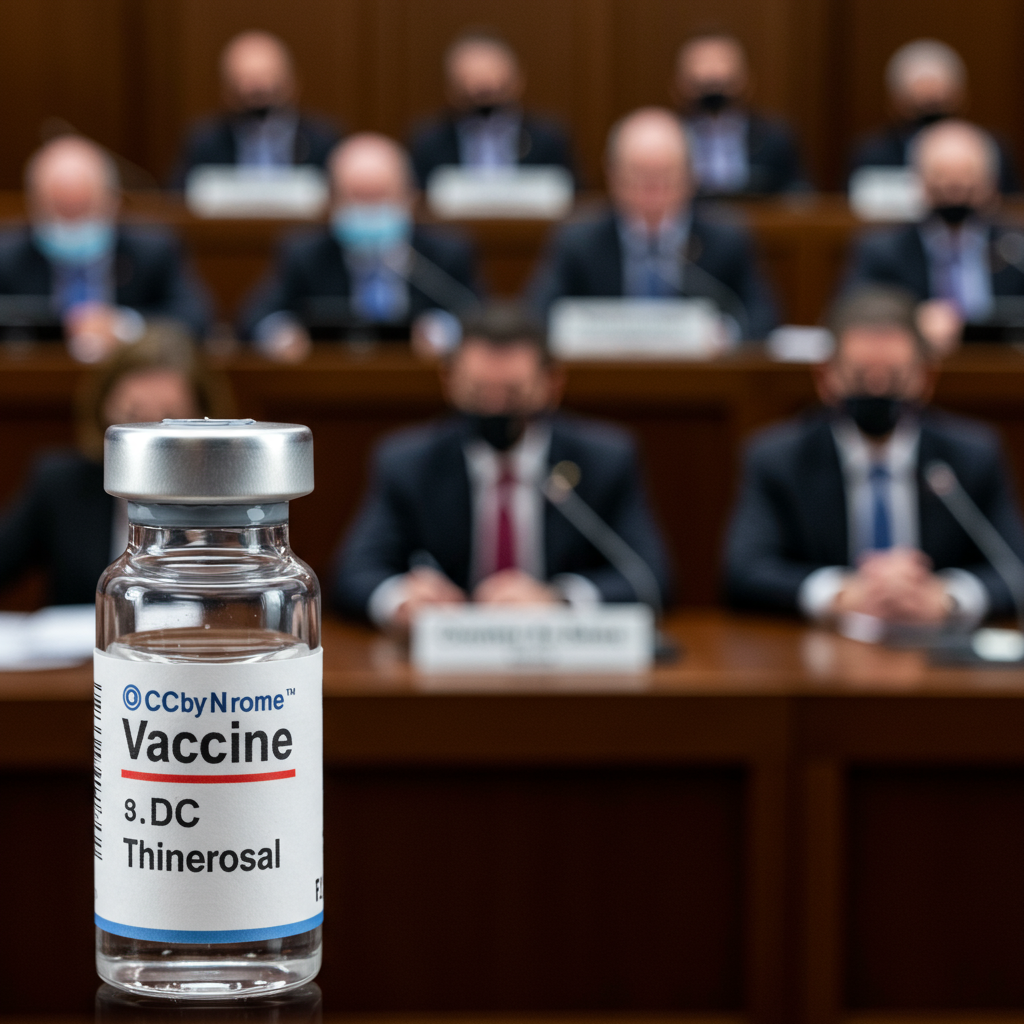The U.S. Centers for Disease Control and Prevention (CDC) is facing scrutiny over a recent recommendation regarding a long-used vaccine ingredient: thimerosal. This preservative has been the subject of intense debate for decades, often targeted by those skeptical of vaccine safety, despite strong scientific evidence affirming its safety at levels used in vaccines. A newly composed CDC advisory panel recently voted to recommend removing thimerosal from flu vaccines, sparking alarm among public health experts.
Why is this happening now? And if studies show thimerosal is safe, why is it being removed – not for the first time? Understanding this complex issue requires looking at the history of vaccine preservatives, the science behind thimerosal, and the pressures influencing public health policy.
What is Thimerosal and Why Was it Used?
Thimerosal is a mercury-containing compound used as a preservative in some multi-dose vaccine vials. Introduced in the 1930s, its purpose was to prevent dangerous contamination. Before preservatives, multi-dose vials posed a risk; every time a needle punctured the vial to draw a dose, bacteria or fungi could be introduced. This could lead to potentially deadly infections if the contaminated vaccine was administered. Experts like Dr. Jason Goldman, president of the American College of Physicians, note that using a preservative like thimerosal was a vital step to ensure the safety of multi-dose vaccine presentations.
The compound contains ethylmercury, which is different from methylmercury. Methylmercury is the type of mercury commonly found in certain fish and can accumulate in the body, posing neurological risks at high exposure levels. Ethylmercury, conversely, is metabolized and cleared from the body much more quickly than methylmercury. According to the CDC, this rapid excretion significantly reduces its potential for harm compared to methylmercury.
For decades, thimerosal was routinely used in various vaccines. However, its use in routine childhood immunizations in the U.S. began to change around the turn of the millennium.
The Controversial 2001 Decision to Remove Thimerosal
In 2001, U.S. federal health officials decided to remove thimerosal from most childhood vaccines. At the time, this included vaccines for diseases like influenza, diphtheria, tetanus, pertussis, and hepatitis B. Thimerosal remained only in trace amounts in some larger, multi-dose vials, primarily for annual flu shots.
This decision was not based on new scientific evidence showing thimerosal was harmful. Instead, as recounted by experts involved at the time, like former ACIP member Dr. Paul Offit, the decision was largely driven by a confluence of political pressure, public perception, and a desire for health agencies to appear responsive to safety concerns.
The late 1990s and early 2000s were a period of heightened public anxiety around vaccines. In 1998, a now-discredited paper by Andrew Wakefield falsely alleged a link between the MMR vaccine (which never contained thimerosal) and autism. While Wakefield’s study was later debunked and his medical license revoked, it fueled the modern anti-vaccine movement. Simultaneously, public health guidelines were being updated to limit exposure to methylmercury. Against this backdrop, health officials faced pressure to address general mercury concerns and demonstrate vigilance, even if the scientific evidence didn’t specifically implicate thimerosal in vaccines.
Experts explain the 2001 removal was framed as an “abundance of caution.” However, many felt it was an “anti-science” move that added cost (single-dose vials are more expensive) without improving safety. Worse, because the decision was poorly explained and not tied to new safety data, many in the public, including anti-vaccine groups like “Moms Against Mercury” and “Generation Rescue” (co-founded by Robert F. Kennedy Jr.), interpreted the removal as an admission by health officials that thimerosal was unsafe. This inadvertently gave credibility to unfounded fears and significantly contributed to public distrust in vaccine safety and the immunization schedule.
The Science is Clear: Thimerosal is Safe in Vaccines
Despite the persistent controversy, the scientific consensus on thimerosal’s safety at vaccine-level doses is overwhelmingly strong. Numerous studies conducted worldwide have investigated potential links between thimerosal and various health issues, including neurological and psychological outcomes, and specifically autism.
Major health organizations like the CDC, FDA, World Health Organization (WHO), and the U.S. Institute of Medicine have reviewed decades of data. Their findings consistently show no evidence of harm caused by the low doses of ethylmercury present in thimerosal-containing vaccines. The ethylmercury is quickly processed and excreted, preventing harmful accumulation in the body. Studies specifically looking for a link between thimerosal-containing vaccines and autism have found none. A 2004 review by the U.S. Institute of Medicine examined over 200 studies and definitively concluded there is no causal relationship between thimerosal and autism. Importantly, autism rates continued to rise after thimerosal was largely removed from childhood vaccines in the U.S., further refuting a link.
Today, the vast majority of vaccines recommended for children in the U.S. are already thimerosal-free. Many never contained it (like MMR or chickenpox vaccines), while others are now supplied only in thimerosal-free, single-dose presentations. Thimerosal is currently found in only a small percentage (estimated 3-4%) of flu vaccines in the U.S., specifically those sold in multi-dose vials. These multi-dose vials are less expensive than single-dose syringes and are primarily used in rural or low-resource settings for efficiency and cost savings.
The Latest ACIP Recommendation: Revisiting a Settled Issue
In June 2024, the CDC’s Advisory Committee on Immunization Practices (ACIP), which sets the U.S. immunization schedule, voted to recommend removing thimerosal from flu vaccines. This recommendation requires formal approval from the CDC’s acting director.
What makes this recommendation particularly controversial and concerning to public health experts is the context surrounding it. The ACIP panel was recently appointed by U.S. Health Secretary Robert F. Kennedy Jr.’s appointee overseeing the CDC. Kennedy Jr. has a long history as a leading figure in the anti-vaccine movement, promoting the unfounded link between thimerosal and autism. Experts note that some of the new ACIP members reportedly lack deep expertise in vaccines and immunology.
Dr. Cody Meissner, the sole pediatrician on the new committee and the only member to vote against the thimerosal removal proposal, stated there was “no scientific evidence that thimerosal has caused problems” and felt revisiting this issue was not a priority for the committee. Experts express concern that normal procedural protocols governing ACIP meetings were not followed. Many expert liaison groups from professional medical organizations, including the American Academy of Pediatrics, boycotted the meeting in protest over the dismissal of the previous highly qualified committee members and the composition of the new panel. Dr. Sean O’Leary of the American Academy of Pediatrics called the meeting “illegitimate.”
Further fueling concerns, a CDC review document supporting thimerosal’s safety was reportedly posted online before the meeting and then removed at the direction of the Secretary’s office. Experts like Dr. Jason Goldman question why a scientifically settled issue is being “re-litigated” by a committee featuring members known for vaccine skepticism. They worry this indicates an agenda to undermine established vaccine science and public trust.
Potential Consequences of the Thimerosal Recommendation
If the recommendation to remove thimerosal from flu vaccines is formally adopted, it could have several practical impacts, though the majority of flu shots in the U.S. are already thimerosal-free.
One immediate concern is how manufacturers will comply and what happens to existing stock of thimerosal-containing multi-dose vials, which are already legally approved. Pharmaceutical companies like Sanofi Pasteur, a major flu vaccine maker, noted that only a “very small number” of their U.S. doses contain thimerosal, awaiting CDC guidance.
A more significant concern revolves around access and cost. Multi-dose vials containing thimerosal are less expensive per dose than single-dose syringes. Organizations and clinics serving lower-resource populations or operating in rural areas often rely on these vials for cost-effectiveness. If they are forced to switch to more expensive single-dose options without corresponding funding increases, it could reduce the number of doses they can purchase and administer.
Public health experts like Dr. O’Leary worry that eliminating even a small percentage (around 3-4%) of the total U.S. flu vaccine supply, especially shortly before flu season, could create shortages in certain areas. This could make it harder for some people to get vaccinated, potentially leading to increased flu cases, hospitalizations, and deaths. Mass vaccination campaigns are already a “herculean task,” and supply chain issues, however small, can hinder efforts to protect communities.
Ultimately, experts fear the greatest impact may be on public trust. Reopening the debate on thimerosal’s safety, particularly under these controversial circumstances, sends a confusing message. It risks validating baseless anti-vaccine claims and further eroding confidence in public health institutions and science, potentially contributing to lower vaccination rates for flu and other diseases.
Frequently Asked Questions
Why did the CDC’s new advisory committee recommend removing thimerosal from flu vaccines?
The recent recommendation by the new ACIP panel to remove thimerosal from flu vaccines came despite decades of scientific consensus on its safety. Experts note the committee was recently appointed by an individual whose appointee oversees the CDC, with some members having backgrounds linked to vaccine skepticism rather than deep scientific expertise. Critics argue the decision appears driven by political and ideological pressures rather than new scientific evidence, aiming to appease anti-vaccine sentiment by revisiting a settled safety issue.
Which types of flu vaccines in the US currently contain thimerosal?
In the United States, thimerosal is primarily found only in multi-dose vials of influenza vaccine. It is used as a preservative to prevent contamination once the vial is opened and multiple doses are drawn. The vast majority of flu vaccines administered in the U.S., including all single-dose syringes, are already thimerosal-free. Estimates suggest only about 3-4% of the total U.S. flu vaccine supply contains thimerosal, mainly used in settings prioritizing cost-efficiency.
Is it necessary to avoid thimerosal-containing vaccines for safety reasons?
No, it is not necessary to avoid thimerosal-containing vaccines for safety reasons based on current scientific evidence. Extensive research by global health organizations like the CDC, FDA, and WHO has consistently found no evidence of harm, including neurological issues or autism, from the low doses of ethylmercury used in vaccine preservatives. The ethylmercury is quickly cleared from the body. Experts emphasize that the proven benefits of vaccination in preventing serious diseases like influenza far outweigh any non-existent safety concerns about thimerosal.
Conclusion
The recent recommendation to remove thimerosal from flu vaccines by a newly appointed CDC advisory panel is less about new science and more about a re-litigation of past controversies. While thimerosal was largely removed from childhood vaccines over two decades ago as a precaution, extensive research since then has consistently reaffirmed its safety. The current move, influenced by a committee composition and process viewed as irregular by many experts, risks undermining public trust and potentially impacting vaccine access, particularly in vulnerable communities. As public health officials navigate this complex issue, clear communication rooted in established science remains crucial to ensure confidence in vital immunization programs.




